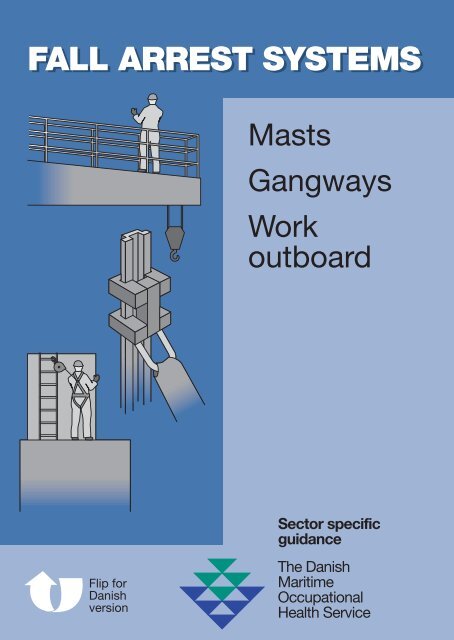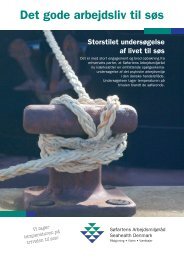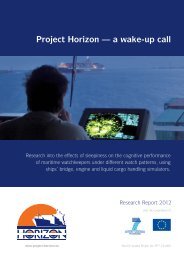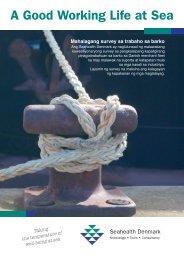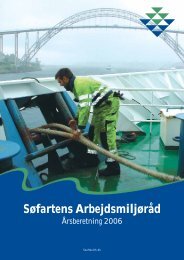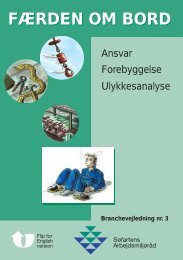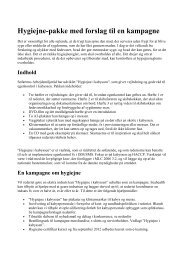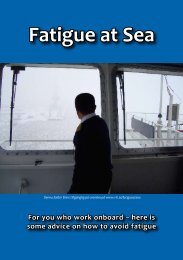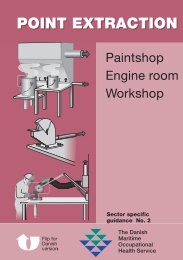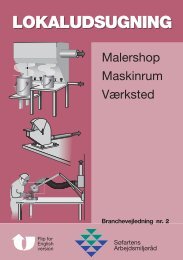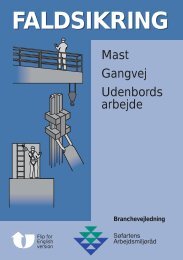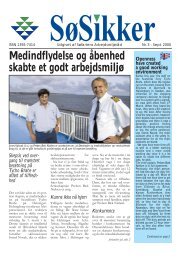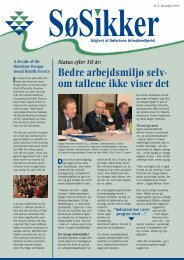FALL ARREST SYSTEMS
Fall Arrest Systems, Sector Specific Guidance
Fall Arrest Systems, Sector Specific Guidance
- No tags were found...
Create successful ePaper yourself
Turn your PDF publications into a flip-book with our unique Google optimized e-Paper software.
<strong>FALL</strong> <strong>ARREST</strong> <strong>SYSTEMS</strong><br />
Masts<br />
Gangways<br />
Work<br />
outboard<br />
Sector specific<br />
guidance<br />
Flip for<br />
Danish<br />
version<br />
The Danish<br />
Maritime<br />
Occupational<br />
Health Service
Sector specific guidance<br />
<strong>FALL</strong><br />
<strong>ARREST</strong><br />
<strong>SYSTEMS</strong><br />
Masts<br />
Gangways<br />
Work outboard<br />
The Danish Maritime Occupational Health Service<br />
2000
© The Danish Maritime Occupational Health Service<br />
ISBN 87-986883-7-5<br />
Print: JBK Offset ApS, Ishøj, Denmark<br />
Text: Eva Thoft, CASA, Copenhagen<br />
Drawings: Pelle Søeborg<br />
Production: Tegneriet ApS, Copenhagen<br />
Translation: Joanna Thompson<br />
Published by<br />
Sales and distribution from<br />
The Danish Maritime Occupational Health Service<br />
Amaliegade 33 B<br />
DK-1256 Copenhagen K<br />
Tel: 045-33 11 18 33<br />
Fax: 045-33 11 14 60<br />
E-Mail: info@seahealth.dk<br />
Iver C. Weilbach & Co. A/S<br />
Toldbodgade 35<br />
DK-1253 Copenhagen K<br />
Tel: 045-33 13 59 27<br />
Fax: 045-33 93 59 27<br />
E-Mail: nautical@weilbach.dk
Why publish sector specific guidance<br />
on fall arrest systems?<br />
Fortunately, it does not happen so often that seamen<br />
experience falls from masts, gangways or in<br />
connection with outboard work. Nevertheless,<br />
when it happens, the injuries sustained can be serious<br />
ones. There is a real danger that these injuries<br />
can be long-term, thereby preventing the victim<br />
from working and in the worst cases, falls can be<br />
fatal.<br />
In order to avoid persons being exposed to potential<br />
injury, it is important that precautions to prevent<br />
falls are taken. Current legislation, however, does<br />
not provide any detailed guidance as to how to<br />
prevent falls, so it can be difficult to find out how to<br />
live up to the law’s requirements in practice. Consequently,<br />
the two sides of the labour market in the<br />
maritime sector have decided to publish their own<br />
sector specific guidance, which is relevant to the<br />
shipping industry. This sector specific guidance<br />
states exactly what the two parties agree upon, as<br />
well as what they recommend as sound practice<br />
with regard to the prevention of falls.<br />
The sector specific guidance is not intended to replace<br />
the vessel’s workplace evaluation. Both<br />
sides of the labour market recommend that a workplace<br />
evaluation always be prepared whenever<br />
anyone has to work at any great height.<br />
The concept "fall arrest systems" in this sector<br />
specific guidance is a broad term and covers any<br />
measures that prevent or limit falls. Examples of<br />
some of these measures include back braces, rails<br />
as well as rigid and flexible anchorage lines etc.<br />
This guidance has been submitted to the Danish<br />
Maritime Authority in order to ensure that it complies<br />
with current legislation and any comments are<br />
included in the text.<br />
Legislation<br />
The guidelines are based upon the following technical regulations:<br />
TheDanish Maritime AuthorityTechnical Regulation A no. 2 of 26th August 1996 on the performance of<br />
work on board ships.<br />
The Danish Maritime Authority’s Technical Regulation A no. 3 of 26th August 1996 on the use of personal<br />
protection on board ships.<br />
The Danish Maritime Authority’s Notice B chapter II-4 (comes into effect on 1st January 2001).<br />
Sector specific guidance The Danish Maritime Occupational Health Service:<br />
Fall Arrest Systems – Why publish sector specific guidance on fall arrest systems?<br />
3
When you should use fall arrest measures<br />
Working on ladders:<br />
Fall arrest measures should be carried out if the<br />
ladder is more than 5 metres high and has a degree<br />
of inclination that exceeds 70 degrees in relation to<br />
the horizontal plane surface.<br />
Risk of free falls:<br />
Fall arrest measures should be carried out if there<br />
is a risk of a free fall of over 2 metres.<br />
Both sides of the maritime labour market recommend<br />
that foremen and seamen should always<br />
make an assessment of each individual case. It is<br />
possible that fall arrest measures are necessary at<br />
lower heights, e.g. if there is ice on surfaces, if the<br />
work has to be done in rough seas or if there are<br />
any other circumstances, which increase the risk of<br />
falls occurring.<br />
See example 1 on page 14.<br />
5 metre<br />
5 meter<br />
2 metre<br />
2 meter<br />
70°<br />
Fall arrest measures should be established<br />
here.<br />
Fall arrest measures should be established<br />
here.<br />
How you should use fall arrest measures<br />
There are several methods to prevent falls: rails,<br />
back braces or fall arrest systems.<br />
Back braces are only relevant where work on ladders<br />
is concerned.<br />
When carrying out work on the mast over a long<br />
period inside the braces, a belt with some form of<br />
back support should also be worn. The lines<br />
should always be secured to a point higher than<br />
the user, so that a fall is impossible.<br />
In the case that work on the mast has to be done<br />
outside a back brace, a full harness must always<br />
be used.<br />
N.B.<br />
It is important to be aware that support belts<br />
are not fall arrest measures – if you only use a<br />
support belt, there is a risk of breaking your<br />
back in a fall.<br />
Always use an approved full harness with<br />
a seat strap.<br />
4<br />
Sector specific guidance The Danish Maritime Occupational Health Service:<br />
Fall Arrest Systems – When you should use fall arrest measures/How you should use fall arrest measures
Ladders with back braces<br />
Max. 50 cm<br />
Max. 200 cm<br />
A<br />
Deck/resting-platform<br />
Dæk/hvileplatform<br />
36°<br />
A<br />
18°<br />
60 cm<br />
Section Snit A-A A-A<br />
Max. 200 cm<br />
Max. 220/250 cm<br />
Sector specific guidance The Danish Maritime Occupational Health Service:<br />
Fall Arrest Systems – Ladders with back braces<br />
5
Fall arrest on ladders<br />
Back braces<br />
Back braces should start at a height of 2.2 metres<br />
above the lowest plane surface. If the back braces<br />
have been in use before the year 2000, the Danish<br />
Maritime Authority accepts that they can start at a<br />
height of 2.5 metres above the lowest plane surface.<br />
If the lowest plane surface is a resting-platform, the<br />
back brace should start at a height of 2 metres over<br />
the platform. The back brace should have a division<br />
of max. 2 metres and the two parts should be<br />
connected internally by a minimum of 4 vertical<br />
rods. The rods should be no further than 170 mm<br />
apart from each other. The requirements as to existing<br />
back braces are described in the Danish<br />
Shipyard Standard (50027).<br />
Back braces<br />
Rigid anchorage<br />
line<br />
Rigid and flexible anchorage<br />
line system<br />
Flexible<br />
anchorage<br />
line<br />
See example 2 on page 14.<br />
Requirements for newbuildings and reconditioning,<br />
see page 12.<br />
Fall arrest systems<br />
Fall arrest measures must be established from a<br />
height of max. 2 metres. There are two kinds of fall<br />
arrest system, which can be fitted onto ladders: the<br />
rigid anchorage line and the flexible anchorage<br />
line.<br />
Both systems consist of a slide valve that can<br />
move up and down a vertical line or band. In the<br />
case of a fall, both of these block immediately. The<br />
slide valve is secured to the harness by a strap,<br />
which should be as short as possible. The glide<br />
valve should only be used with the lines or tracks<br />
that it is designed for.<br />
The flexible anchorage system is less sensitive<br />
than the rigid anchorage system with regard to salt<br />
coating, rough treatment and wear and tear. Therefore,<br />
the two parties on the maritime labour market<br />
recommend the use of the flexible anchorage line<br />
outdoor.<br />
See example 3 on page 15.<br />
For requirements as to newbuildings and reconditioning,<br />
see page 12.<br />
The new, more stringent requirements of the Danish Maritime Authority<br />
If the vessel has ladders without any form of fall arrest measures, some form of fall arrest system must<br />
be established.<br />
If the shipping company chooses back braces, platforms should be established at 5-metre intervals.<br />
If the shipping company chooses a solution with flexible or rigid anchorage systems, platforms should<br />
be established at 15-metre intervals.<br />
(The Danish Maritime Authority’s Notice B, chapter II-4, Rule no. 7).<br />
6<br />
Sector specific guidance The Danish Maritime Occupational Health Service: Fall Arrest Systems – Fall arrest on ladders
Fall arrest on crane jibs<br />
The two parties of the maritime labour market are<br />
not as yet familiar with many practical examples of<br />
the establishment of fall arrest measures on crane<br />
jibs, but the following possibilities exist:<br />
It is recommended that precautions against falls<br />
should be taken by fitting a fixed rail that runs the<br />
entire length of the crane jib.<br />
See example 4 on page 15.<br />
Crane jib with fixed rail<br />
On existing vessels, there can be practical circumstances<br />
that make it extremely difficult to fit fixed<br />
rails. In these cases it is recommended to try a solution<br />
by which the person working can be protected<br />
by means of a wire stretched along the<br />
stanchion to which the fall arrest system can be<br />
connected. Two short lines with snap hooks should<br />
be used, so that one of them is securely fixed when<br />
the other is loosened when passing a stanchion.<br />
Wire extended by means of<br />
stanchion<br />
Finally, a fall arrest system can be established by<br />
means of a wire, that is to say, a wire that is<br />
stretched out on the crane jib at e.g. a height of 10<br />
cm. The fall arrest system can then be coupled to<br />
this wire. This system should only be considered,<br />
however, if practical reasons prevent the utilisation<br />
of the other possibilities mentioned on this page.<br />
Wire fitted at a height of 10 cm<br />
Sector specific guidance The Danish Maritime Occupational Health Service: Fall Arrest Systems – Fall arrest on crane jibs<br />
7
Fall arrest on gangways<br />
In the case of the rigging and dismantling of gangways,<br />
drop tackle is particularly suitable for fall arrest.<br />
A drop tackle works in the same way as a safety<br />
belt in a car. The wire/webbing slides slowly in and<br />
out as long as a person moves at normal speed,<br />
but a fall will instantly block the wire/webbing. An<br />
in-built sliding brake (energy-absorber) wards off<br />
the shock of a fall. The blockading is automatically<br />
broken off when the pull stops. The drop tackle is<br />
secured to an anchor point – preferably hung vertically<br />
over the place of work.<br />
See example 5 on page 16.<br />
Drop tackle<br />
Requirements as to fall arrest equipment<br />
Fall arrest measures must live up to a number of<br />
safety requirements. Fall arrest equipment purchased<br />
within the EU countries complies with<br />
these requirements if it has a CE label. Equipment<br />
purchased outside the EU must also comply with<br />
the same standards. If it proves impossible to obtain<br />
CE-labelled equipment, you should ask the<br />
supplier if the equipment meets the same requirements<br />
as the CE-labelled equipment.<br />
Harnesses<br />
It is absolutely necessary to wear a proper harness<br />
in order to stop a free fall. The harness should be<br />
the full harness, which has straps that go over the<br />
chest, waist, seat and thighs. The harness should<br />
be fastened in such a way that the person wearing<br />
it hangs upright after a fall. The harness should sit<br />
tightly on the person using it and loose clothing<br />
should not be worn under the harness.<br />
Full harness<br />
8<br />
Sector specific guidance The Danish Maritime Occupational Health Service:<br />
Fall Arrest Systems – Fall arrest on gangways/Requirements as to fall arrest equipment
Lines<br />
There are two types of line:<br />
Elasticised lines are suitable for stopping a free fall<br />
as they extend in the case of a fall. When they bear<br />
a load weighing 1,000 kg, they should be between<br />
30% and 60% longer than their original, unloaded<br />
length.<br />
Un-elasticised lines may only be used together<br />
with a sliding brake (energy-absorber). When using<br />
an energy-absorber, it is important always to know<br />
the fully extended length of this.<br />
See example 6 on page 16.<br />
The line should always be secured to the ship – i.e.<br />
to a fixed anchor point. Persons or loose objects<br />
cannot stop a person’s fall.<br />
Securing the line<br />
Drop tackle<br />
As described under »Fall arrest for gangways«,<br />
drop tackle works in the same way as a safety belt.<br />
The line should be secured to a point that you are<br />
absolutely certain can stand the load it will have to<br />
bear in the case of a fall. This load has been calculated<br />
to weigh 1,000 kg.<br />
The length of the free fall must be limited as much<br />
as possible, so it is important to secure the line to<br />
a point that is higher up than the user, as well as not<br />
being too far out to the side.<br />
See example 5 on page 16.<br />
Securing the line<br />
Sector specific guidance The Danish Maritime Occupational Health Service:<br />
Fall Arrest Systems – Requirements as to fall arrest equipment<br />
9
Checking before use<br />
Fall arrest equipment should always be checked<br />
before use. The supplier can illustrate how the<br />
equipment can be checked. Guard and sliding systems<br />
should be kept clean.<br />
Equipment should be thrown out or<br />
should be given an authorised service if:<br />
• it has already stopped a fall<br />
• any defects which impair the functioning of<br />
the equipment are discovered<br />
The supplier or other experts should carry<br />
out any necessary repairs.<br />
Maintenance and service<br />
In order to work properly, harnesses, slide valves<br />
and other loose equipment should be kept clean,<br />
stored in a dry place and protected against direct<br />
sunlight.<br />
Fall arrest equipment should be<br />
inspected at least once a year:<br />
• Harnesses and belts should be inspected<br />
for breakage, cracks, wear and tear and<br />
other damage.<br />
• Buckles, shackles, snap hooks and drop<br />
tackle should be tested to see if they work<br />
properly and inspected for wear and tear<br />
and damage.<br />
• Wires and lines should be inspected for<br />
wear and tear and damage.<br />
• Splices should be inspected for wear and<br />
tear and damage.<br />
• Welds on anchor points should be<br />
checked.<br />
• Tracks should be inspected for wear and<br />
tear and damage.<br />
• The results of the inspection should be registered<br />
on board and signed by a person<br />
in a position of responsibility.<br />
Part of the inspection can be carried out on board<br />
the vessel, since it can be inconvenient or even impossible<br />
to allow an authorised repairman to inspect<br />
all the equipment every year. By this is meant<br />
those parts of the equipment that do not have mechanical<br />
parts (wires and harnesses) as well as the<br />
stationary parts of the fall arrest system. It is necessary<br />
to keep records on board concerning<br />
maintenace and service of the equipment. It should<br />
be made clear, which person on board has the responsibility<br />
for making sure that these checks and<br />
inspections are carried out. The shipping company<br />
ought to enter into an agreement with the supplier<br />
as to which parts of the equipment that the personnel<br />
on board are allowed to check. Furthermore,<br />
the supplier should also give instructions as<br />
to how the equipment should be properly checked.<br />
10<br />
Sector specific guidance The Danish Maritime Occupational Health Service:<br />
Fall Arrest Systems – Checking before use/Maintenance and service
Whose job is it?<br />
The shipping company should make sure that<br />
suitable fall arrest equipment is provided on board.<br />
The foreman should:<br />
• Make sure that fall arrest precautions are<br />
taken when necessary.<br />
• Give instructions and train seamen in the<br />
use, adjustment, maintenance and storage<br />
of fall arrest equipment, based on the supplier’s<br />
directions for use.<br />
• Provide information on the dangers of not<br />
using fall arrest equipment.<br />
• Be responsible for checking and inspecting<br />
fall arrest equipment.<br />
The supplier of the fall arrest equipment should<br />
provide directions for use, including the necessary<br />
information as to the special characteristics,<br />
adjustment, correct use, maintenance and storage<br />
of the equipment.<br />
The Safety Committee is responsible for drafting<br />
workplace evaluations. In the case of vessels without<br />
a safety organisation, it is the responsibility of<br />
the master to prepare workplace evaluations.<br />
The individual seaman:<br />
• Should make use of the fall arrest equipment<br />
when it is required.<br />
• Check the equipment before use.<br />
Sector specific guidance The Danish Maritime Occupational Health Service: Fall Arrest Systems – Whose job is it?<br />
11
Newbuildings and reconditioning<br />
The two sides of the maritime labour market recommend<br />
that, as far as possible, the shipping<br />
companies should include the best possible solutions<br />
from this sector specific guidance when new<br />
vessels are built or when existing ships are reconditioned.<br />
The ship’s workplace evaluation can reveal where<br />
it is appropriate to make minor changes when a<br />
ship is being reconditioned. These could, for instance,<br />
include the establishment of new anchorage<br />
points for fall arrest systems, platforms or rails<br />
– e.g. on crane jibs.<br />
The shipping company should consider establishing<br />
back braces when a ship is to be built or reconditioned.<br />
With back braces, there is always<br />
some protection to ward off a fall.<br />
The different characteristics of back braces and fall arrest systems:<br />
BACK BRACES<br />
Fall arrest is always at hand –<br />
even when simple jobs have to be done,<br />
e.g. changing light bulbs in the lanterns.<br />
They ward off a fall but do not break<br />
it if a person is unconscious.<br />
Are not suitable on all ships<br />
Can only be used in connection with ladders<br />
and are not suitable for all working functions.<br />
A fall arrest system has to be used anyway if<br />
there is work to be done outside the back<br />
brace or if the work is a major job and takes<br />
a long time.<br />
<strong>FALL</strong> <strong>ARREST</strong> <strong>SYSTEMS</strong><br />
Fall arrest systems still require instruction and<br />
monitoring as well as a great deal of preparation<br />
and checking – all this can seem to be too<br />
much trouble if it is only a simple job that has<br />
to be done.<br />
Break the fall regardless of whether the person<br />
is unconscious or not.<br />
Can be adapted to the individual ship.<br />
Can be adapted to the individual working<br />
function.<br />
New requirements as to back braces<br />
Back braces should be fitted from 2.2 metres<br />
above the level surface. Back braces should go at<br />
least 1 meter above the surface plane to which the<br />
ladder leads, so that falls are arrested when work is<br />
to be carried out at the very top.<br />
Platforms should be established at 5 metre intervals<br />
and the sections of the ladder should be staggered<br />
at least 90 degrees in relation to each other.<br />
The platforms should be of an appropriate size – at<br />
least 600 mm x 600 mm. They should be covered<br />
with a non-slip surface and have a 1-metre high rail<br />
around them. The rail should have knee and foot<br />
lists.<br />
These requirements are described in the Danish<br />
Maritime Authority’s Notice B, chapter II-4, rule<br />
no. 7. Requirements as to the dimensions of the<br />
back braces are described in the Danish Shipyard<br />
Standard DVS 50027.<br />
Please note that although DVS 50027 states that<br />
back braces should start at a height of 2.5 metres,<br />
the required height at present according to the<br />
Danish Maritime Authority is 2.2 metres.<br />
12<br />
Sector specific guidance The Danish Maritime Occupational Health Service:<br />
Fall Arrest Systems – Newbuildings and reconditioning
Requirements as to anchorage points for fall<br />
arrest equipment<br />
Anchorage points such as wires or bands should<br />
be fitted uninterruptedly along the entire length of<br />
the access route and at least 1 metre over the level<br />
that the ladder leads to.<br />
Platforms should be established at 15-metre intervals.<br />
The platforms should be constructed in the<br />
same way as for back braces.<br />
Anchorage points that are used for drop tackle<br />
should be able to withstand a load of 1,000 kg. The<br />
anchorage point should be positioned directly over<br />
the place where the work is carried out.<br />
Read more about it<br />
Regulations and standards:<br />
1. The Danish Maritime Authority’s Technical Regulation<br />
A, no. 2 of 26th August 1996 on the performance<br />
of work on board ships<br />
2. The Danish Maritime Authority’s Technical Regulation<br />
A, no. 3 of 26th August 1996 on the use of<br />
personal protection on board ships<br />
3. The Danish Maritime Authority’s Notice B, chapter<br />
II-4, Rule no. 7<br />
4. The Danish Working Enviromental Authority's<br />
AT-Notice no. 4.09.2 on fall arrest – this can be<br />
found on the Danish Working Enviromental Authority's<br />
home page: www.at.dk<br />
8. The Working Environment Manual issued by<br />
the Danish Maritime Occupational Health<br />
Service contains guidelines for working at<br />
heights. Here you can see the other forms of<br />
protection that can be relevant. There is also<br />
some good advice on planning and giving instructions<br />
where working on scaffolding etc.<br />
is concerned.<br />
The Working Environmental Manual is regularly<br />
brought up to date, so it is possible that<br />
some time in the future new sections, which<br />
are relevant in connection with fall prevention,<br />
may be added.<br />
5. The Danish Working Enviromental Authority's instruction<br />
no. 2.2.0.1 on machines and machinery<br />
– this can be found on the Danish Working<br />
Enviromental Authority's home page: www.at.dk<br />
6. Danish Standard DS/EN363<br />
7. Danish Shipyards’ Standardisation Committee’s<br />
Shipyard Standard DVS 50027.<br />
Sector specific guidance The Danish Maritime Occupational Health Service:<br />
Fall Arrest Systems – Newbuildings and reconditioning/Read more about it<br />
13
Examples<br />
Example 1 - fall arrest by fixed railings<br />
Example 2 – back braces<br />
The platform positioned forward on the ship for the<br />
radar scanner. When working on this platform,<br />
there is a risk of a free fall of over two metres, which<br />
is why fall arrest precautions should be employed.<br />
Normally in such cases, the Danish Maritime Authority<br />
would require rails. The ladders that lead up<br />
to the platform are less than 5 metres, so no fall arrest<br />
precautions are required here.<br />
The vessel is a Danish passenger ship built in 1994.<br />
The back braces have been introduced to comply<br />
with DVS 50027. The starting point for back braces<br />
is less than 2.5 metres measured from the breakwater.<br />
In this case it is the platform that is the starting<br />
point for the measuring. For simple tasks that<br />
can be quickly carried out, no further fall arrest<br />
measures are necessary, provided that the person<br />
concerned works inside the back brace.<br />
The vessel is a Danish drycargo carrier, built in<br />
1992.<br />
14<br />
Sector specific guidance The Danish Maritime Occupational Health Service: Fall Arrest Systems - Examples
Example 3 - wire system<br />
Example 4 – fall arrest on crane jib<br />
The ladder on the ship’s forward mast was not<br />
equipped with any form of fall arrest measures at<br />
all. A wire system has later been fitted to the ladder.<br />
When anyone needs to climb the mast, they<br />
must always wear a full harness. The person concerned<br />
is connected to the wire by means of a line<br />
and a slide valve. The line is equipped with an integrated<br />
shock absorber.<br />
The ship’s crane jib is equipped with a rail, so it is<br />
possible for the person to move around without<br />
further fall arrest precautions. Access to the crane<br />
is equipped with back braces in compliance with<br />
DVS 50027. If a person moves outside the rail or<br />
back brace, he must use a harness and line.<br />
The vessel is a Danish drycargo carrier built in<br />
1989.<br />
Sector specific guidance The Danish Maritime Occupational Health Service: Fall Arrest Systems – Examples 15
Example 5 – rigging of gangway<br />
Example 6 – risk of free fall<br />
Here, drop tackle along with a harness is used. In<br />
order to make sure that the securing point is always<br />
vertically above the person working, a horizontal<br />
wire running the entire length of the gangway<br />
has been fitted on the deck. In this way, it is<br />
certain that the drop tackle will follow the person<br />
on the gangway. The person in the photo is wearing<br />
both a life jacket and a harness. Make sure that<br />
the line is always secured to the full harness – not<br />
to the life jacket.<br />
Here is an example of fall arrest when there is a risk<br />
of a free fall of more than 2 metres. The person<br />
working is wearing a full harness which, by means<br />
of a sliding lock, is secured to the line. The sliding<br />
lock has an integrated shock absorber. The line<br />
should be firmly secured to a fixed anchorage<br />
point.<br />
16<br />
Sector specific guidance The Danish Maritime Occupational Health Service: Fall Arrest Systems – Examples


